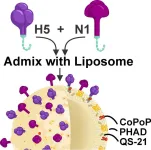(Press-News.org) NASA’s Curiosity rover has uncovered a hidden chemical archive of ancient Mars’ atmosphere, which suggests that large amounts of carbon dioxide have been locked into the planet’s crust, according to a new study. The findings provide in situ evidence that a carbon cycle once operated on ancient Mars and offer new insights into the planet’s past climate. The Martian landscape shows clear signs that liquid water once flowed across its surface, which would have required a much warmer climate than the planet has today. It is therefore thought that Mars’ CO2 atmosphere must have been thicker in the past, to maintain warmer conditions. A climate containing abundant liquid water and atmospheric CO2 is expected to have reacted with Martian rocks, triggering geochemical processes that produce carbonate minerals. However, while previous analyses of Martian rock have detected the presence of carbonates, the quantities found were lower than expected from geochemical models.
Using data from the Curiosity rover, Benjamin Tutolo and colleagues investigated carbonate minerals in part of Gale crater – which once contained an ancient lake. In 2022 and 2023, Curiosity drilled four rock samples from different stratigraphic units representing transitions from lakebed to wind-blown environments and analyzed their mineralogy using the rover’s onboard X-ray diffractometer. Tutolo et al. identified siderite (iron carbonate) in high concentrations – ranging from approximately 5% to over 10% by weight – within magnesium sulfate-rich layers. This was unexpected, because orbital measurements had not detected carbonates in these strata. Given its provenance and chemistry, the authors infer that the siderite formed by water-rock reactions and evaporation, indicating that CO₂ was chemically sequestered from the Martian atmosphere into the sedimentary rocks. If the mineral composition of these sulfate layers is representative of sulfate-rich regions globally, those deposits contain a large, previously unrecognized carbon reservoir. The carbonates have been partially destroyed by later processes, indicating that some of the carbon dioxide was later returned to the atmosphere, forming a carbon cycle. “As details of Mars’ geochemistry are discovered through orbital and rover investigations around the planet, additional clues are revealed about the diversity of potentially habitable environments,” write Janice Bishop and Melissa Lane in a related Perspective.
END
Curiosity rover identifies carbonates, providing evidence of a carbon cycle on ancient Mars
Summary author: Walter Beckwith
2025-04-17
ELSE PRESS RELEASES FROM THIS DATE:
Up to 17% of global cropland contaminated by toxic heavy metal pollution, study estimates
2025-04-17
Based on data from over 1000 regional studies combined with machine learning, researchers estimate that as many as 1.4 billion people live in areas with soil dangerously polluted by heavy metals like arsenic, cadmium, cobalt, chromium, copper, nickel, and lead. The study reveals a global risk, but also a previously unrecognized high-risk, metal-enriched zone in low-latitude Eurasia, in particular. The growth in demand for critical metals means toxic heavy metal pollution in soils is only likely to worsen. “We hope that the global soil pollution data presented in this report will ...
Curiosity rover finds large carbon deposits on Mars
2025-04-17
Research from NASA’s Curiosity rover has found evidence of a carbon cycle on ancient Mars, bringing scientists closer to an answer on whether the Red Planet was ever capable of supporting life.
Lead author Dr. Ben Tutolo, PhD, an associate professor with the Department of Earth, Energy and Environment in the Faculty of Science at the University of Calgary, is a participating scientist on the NASA Mars Science Laboratory Curiosity Rover team.
The team is working to understand climate transitions and habitability on ancient Mars as Curiosity explores Gale Crater.
The paper, published this week in the journal Science, reveals that ...
CHOP, Penn Medicine researchers use deep learning algorithm to pinpoint potential disease-causing variants in non-coding regions of the human genome
2025-04-17
Philadelphia, April 17, 2025 – Researchers from Children’s Hospital of Philadelphia (CHOP) and the Perelman School of Medicine at the University of Pennsylvania (Penn Medicine) have successfully employed an algorithm to identify potential mutations which increase disease risk in the noncoding regions our DNA, which make up the vast majority of the human genome. The findings could serve as the basis for detecting disease-associated variants in a range of common diseases. The findings were published online today by the American Journal of Human Genetics.
While certain sections ...
Prevalence of obesity with and without confirmation of excess adiposity among US adults
2025-04-17
About The Study: Among U.S. adults ages 20 to 59, the prevalence of obesity by body mass index (BMI) only was nearly identical with the obesity prevalence after confirmation of excess adiposity. Approximately 98% of individuals identified as having obesity based on BMI had excess adiposity.
Corresponding Author: To contact the corresponding author, Michael Fang, PhD, MHS, email mfang9@jh.edu.
To access the embargoed study: Visit our For The Media website at this link https://media.jamanetwork.com/
(doi:10.1001/jama.2025.2704)
Editor’s Note: Please ...
Population attributable fraction of incident dementia associated with hearing loss
2025-04-17
About The Study: The results of this cohort study suggest that treating hearing loss might delay dementia for a large number of older adults. Public health interventions targeting clinically significant audiometric hearing loss might have broad benefits for dementia prevention. Future research quantifying population attributable fractions should carefully consider which measures are used to define hearing loss, as self-reporting may underestimate hearing-associated dementia risk.
Corresponding Author: To contact the corresponding ...
New study reveals how cleft lip and cleft palate can arise
2025-04-17
CAMBRIDGE, MA -- Cleft lip and cleft palate are among the most common birth defects, occurring in about one in 1,050 births in the United States. These defects, which appear when the tissues that form the lip or the roof of the mouth do not join completely, are believed to be caused by a mix of genetic and environmental factors.
In a new study, MIT biologists have discovered how a genetic variant often found in people with these facial malformations leads to the development of cleft lip and cleft palate.
Their findings suggest that the variant diminishes cells’ supply of transfer RNA, a molecule ...
Scientists hack cell entry to supercharge cancer drugs
2025-04-17
A new discovery could pave the way for more effective cancer treatment by helping certain drugs work better inside the body.
Scientists at Duke University School of Medicine, University of Texas Health Science Center at San Antonio, and University of Arkansas have found a way to improve the uptake of a promising class of cancer-fighting drugs called PROTACs, which have struggled to enter cells due to their large size.
The new method works by taking advantage of a protein called CD36 that helps pull substances into cells. By designing drugs to use this CD36 pathway, researchers delivered 7.7 to 22.3 times more of the drug inside cancer cells, making ...
Study: Experimental bird flu vaccine excels in animal models
2025-04-17
BUFFALO, N.Y. — A vaccine under development at the University at Buffalo has demonstrated complete protection in mice against a deadly variant of the virus that causes bird flu.
The work, detailed in a study published today (April 17) in the journal Cell Biomaterials, focuses on the H5N1 variant known as 2.3.4.4b, which has caused widespread outbreaks in wild birds and poultry, in addition to infecting dairy cattle, domesticated cats, sea lions and other mammals.
In the study, scientists describe a process they’ve developed for creating doses with precise ...
Real-world study finds hydroxyurea effective long-term in children living with sickle cell disease
2025-04-17
(WASHINGTON, April 17, 2024) — Hydroxyurea remains effective long-term in reducing emergency department visits and hospital days for children living with sickle cell disease (SCD), according to new research published in Blood Advances.
“This is one of the first large, real-world, long-term studies to assess the efficacy of hydroxyurea outside of a controlled setting,” said study author Paul George, MD, a pediatric hematology/oncology fellow and PhD candidate at Emory University School of Medicine and Aflac Cancer and Blood Disorders Center at Children’s ...
FAU designated a National Center of Academic Excellence in Cyber Research
2025-04-17
Florida Atlantic University has been recognized as a National Center of Academic Excellence in Cyber Research (CAE-R) by the National Security Agency (NSA) and its partners in the National Centers of Academic Excellence in Cybersecurity (NCAE-C). This prestigious designation, awarded through the academic year 2030, affirms the university’s leadership and innovation in the field of cybersecurity research at the doctoral level.
This recognition places FAU among an elite group of institutions nationwide that have demonstrated a sustained commitment to cutting-edge research in cyber defense and security. The CAE-R designation is awarded to universities whose programs meet rigorous ...
LAST 30 PRESS RELEASES:
Making lighter work of calculating fluid and heat flow
Normalizing blood sugar can halve heart attack risk
Lowering blood sugar cuts heart attack risk in people with prediabetes
Study links genetic variants to risk of blinding eye disease in premature infants
Non-opioid ‘pain sponge’ therapy halts cartilage degeneration and relieves chronic pain
AI can pick up cultural values by mimicking how kids learn
China’s ecological redlines offer fast track to 30 x 30 global conservation goal
Invisible indoor threats: emerging household contaminants and their growing risks to human health
Adding antibody treatment to chemo boosts outcomes for children with rare cancer
Germline pathogenic variants among women without a history of breast cancer
Tanning beds triple melanoma risk, potentially causing broad DNA damage
Unique bond identified as key to viral infection speed
Indoor tanning makes youthful skin much older on a genetic level
Mouse model sheds new light on the causes and potential solutions to human GI problems linked to muscular dystrophy
The Journal of Nuclear Medicine ahead-of-print tip sheet: December 12, 2025
Smarter tools for peering into the microscopic world
Applications open for funding to conduct research in the Kinsey Institute archives
Global measure underestimates the severity of food insecurity
Child survivors of critical illness are missing out on timely follow up care
Risk-based vs annual breast cancer screening / the WISDOM randomized clinical trial
University of Toronto launches Electric Vehicle Innovation Ontario to accelerate advanced EV technologies and build Canada’s innovation advantage
Early relapse predicts poor outcomes in aggressive blood cancer
American College of Lifestyle Medicine applauds two CMS models aligned with lifestyle medicine practice and reimbursement
Clinical trial finds cannabis use not a barrier to quitting nicotine vaping
Supplemental nutrition assistance program policies and food insecurity
Switching immune cells to “night mode” could limit damage after a heart attack, study suggests
URI-based Global RIghts Project report spotlights continued troubling trends in worldwide inhumane treatment
Neutrophils are less aggressive at night, explaining why nighttime heart attacks cause less damage than daytime events
Menopausal hormone therapy may not pose breast cancer risk for women with BRCA mutations
Mobile health tool may improve quality of life for adolescent and young adult breast cancer survivors
[Press-News.org] Curiosity rover identifies carbonates, providing evidence of a carbon cycle on ancient MarsSummary author: Walter Beckwith


